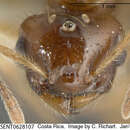en
names in breadcrumbs


Crematogaster limata is an extremely generalized species. It occurs most abundantly from sea level to 1000m elevation, where it can be found in wet forest or dry forest, second growth or mature vegetation. It is most abundant in disturbed vegetation in wet forest areas. It is most often encountered near ground level, along roadsides, at forest edges, or in the understory of second growth vegetation. I rarely find it in mature forest.
Nests occur in almost any kind of small cavity. I most often find them in dead sticks, but other nest sites have included cavities in live stems of various plant species, an abandoned mud nest of a sphecid wasp, live internodes of Cecropia saplings, and rotting cacao pods.
Colonies may be small, with a single queen in a single nest. Larger colonies may fill many sticks and cavities scattered through a volume of a cubic meter or more, with a central nest containing the queen and abundant brood, and peripheral nests containing workers and brood or very often large aggregations of workers alone, with no brood. Colonies may be monogynous or polygynous. Many colonies that I have observed have contained a single queen, but polygynous colonies are also relatively common. One nest at Hitoy Cerere Biological Reserve in Costa Rica contained 21 physogastric queens. Foundress queens are usually found alone; but I once observed a pair of founding queens together in a small stick, suggesting that pleometrosis occurs at least occasionally.Workers are omnivorous foragers. They recruit to baits and frequently tend extrafloral nectaries and Homoptera. Workers can be found foraging day or night.
Wheeler (1986) observed a behavioral association between C. limata and the large ponerine ant Ectatomma tuberculatum on Barro Colorado Island in Panama. Ectatomma tuberculatum nests in the ground at the bases of trees. The nest entrance is surmounted by a 2-3cm wide thatch tube that extends about 15cm up the side of a tree trunk or smaller plant stem. Wheeler observed that polydomous C. limata nests were often located near the mouths of E. tuberculatum nests, and that C. limata carried out periodic "raids" into the these nests. The raids were abrupt and short-lived, with workers streaming into and out of a nest entrance for about an hour. Peak flux rates were about 170 workers entering and 170 workers exiting per 15 minute observation period. Wheeler writes "Encountering an E. tuberculatum, the smaller C. limata climbed up one of the larger ant's legs and onto its thorax and head. The E. tuberculatum worker stood still as the C. limata licked the dorsal surface, especially the head. E. tuberculatum did not react aggressively to the intruders. Occasionally, an E. tuberculatum worker opened her jaws as the C. limata licked the extended mouthparts. Then the C. limata worker climbed down and quickly left the nest."
Although Wheeler did not observe the phenomenon during a brief visit to Finca La Pacifica in the dry forest habitat of northwestern Costa Rica, where she examined five E. tuberculatum nests, I suspect that the phenomenon occurs in Costa Rica. In the Atlantic lowlands I have seen several instances of large C. limata colonies with nests clustered in and around nest entrances of E. tuberculatum.
In the Santa Marta region, many C. limata nests contained abundant inquiline beetles in the genus Gnostus (Ptinidae).
Mexico to Bolivia and southern Brazil.
Taxonomic history
Combination in Crematogaster (Orthocrema): Wheeler, 1921f PDF: 151.Combination in Crematogaster (Orthocrema): Blaimer, 2012c PDF: 55.Senior synonym of Crematogaster inca ascendens: Longino, 2003a PDF: 79.Senior synonym of Crematogaster limata dextella: Longino, 2003a PDF: 79.Senior synonym of Crematogaster limata palans: Longino, 2003a PDF: 79.